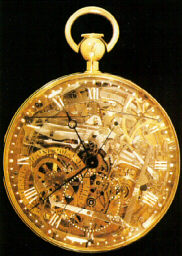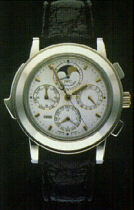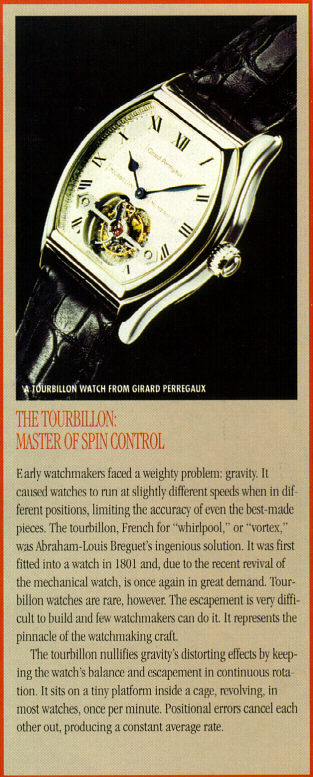
 |
 The Vallee de Joux, where nearly all complicated Swiss watches are made |
When Marie Antoinette's lover (who was a member of her palace guard) wanted to impress her he ordered for her something sure to knock her silk stockings off. It was a watch that could not only tell the time, but chime the hours, show the difference between solar and mean time, keep track of the date, even during leap years, and much else.
Its multiplicity of extra functions, called "complications," make the Marie Antoinette watch, produced by the workshop of the great Abraham-Louis Breguet, one of the most famous timepieces ever made. (The Queen, beheaded 27 years before the watch was completed in 1820, never got to revel in its glory. Nor can we. In 1976 it disappeared after a looting of the museum in Jerusalem where it was kept. Its whereabouts now is one of the great mysteries of the watch world.)
Earlier this century complications were at the heart of a horological duel between two rich watch collectors. It started when auto magnate James Ward Packard commissioned Patek Philippe to make him the most complicated- watch in the world. In 1927, he plopped down $16,000 for his new treasure, so intricate it even showed the star-lit sky exactly as it appeared from his bedroom window in Warren, Ohio. (In 1988 Patek Philippe purchased the watch from the American Watchmakers institute, to which it had been donated, for $1.3 million.)
When rival collector Henry Graves Jr. heard of Packard's triumph, he asked Patek to make him an even more complicated watch. The 900-part timepiece took seven years, until 1933, to complete, and cost $75,000.
It remained the most complicated watch in the world until 1989, when Patek once again outdid itself with Calibre '89, a grapefruit-sized wonder with a record 33 complications. Patek auctioned it off in April 1989 for $2.7 million, the most ever paid for a timepiece at auction. Calibre '89 made one thing very clear: Complications remain the ne plus ultra of the watchmaker's art, more valued now than ever before. About 95% of the complicated watches made in Switzerland are the work of craftsmen in the serene Vallee de Joux. There, in the tiny villages that dot the valley, watchmakers have been specializing in complicated movements for more than 200 years, passing down their skills from father to son.
 | |
| Above: The Marie Antoinette watch Right: A Grande Complication from IWC Schaffhausen |  |
Probably the best-known type of complication is the chronograph. Not to be confused with a chronometer, which is a timepiece that meets certain rigorous standards of accuracy, a chronograph measures intervals of time. It is the same as a stopwatch function.
Chronos show elapsed time by means of a center
seconds hand, a small subdial or subdials on the watch face, or both. Some chronos are able, by means of subdials called minute or hour registers, to keep track of very long periods of time-up to 12 hours. Most chronos are started and stopped by pushing buttons on the side of the watch case. Often, one button is used for starting and stopping the time, another for returning the hand to zero
(12 o'clock).
A split seconds chronograph, also called a rattrapante (French for "catching up"), is used for measuring two or more succeeding intervals of time, as when, for example, you are timing a race with several runners who cross the finish line at different times. The words "split second" refer not to the accuracy of the chronograph, but to the fact that its seconds hand (really two superimposed seconds hands that run together) can, in effect, be split into two hands.
Here's how it works: At the start of the race the wearer pushes the chronograph button, setting the two superimposed hands in motion. As the first runner finishes the race, the wearer pushes a supplementary button stopping the top seconds hand. The bottom hand keeps moving. The wearer records the first runner's time, then pushes the supplementary button again, causing the stopped hand to jump forward and catch up with the still-moving bottom hand. When the second runner finishes, the wearer once again pushes the supplementary button to stop the top hand, records the second runner's time, and pushes the supplementary button to once again make the top hand jump ahead to join the bottom hand. The wearer continues the process until all the runners have finished.
The single-hand split seconds chronograph, like the split seconds chrono, is used for timing successive intervals of time. The wearer stops the chronograph hand when the first runner finishes the race. When he pushes the button to start the chrono again, it jumps forward to where it would be if it had never stopped, thus allowing the second runner's time to be measured without interruption.
Many chronograph watches have numerical scales just inside the perimeter of the watch face that enable a center-seconds chronograph hand to give information other than elapsed time. A tachymeter (or tachometer) scale allows the wearer to measure the speed at which he travels over a measured distance, a measured mile on the highway, for instance. The wearer starts the chronograph when he passes the starting point and stops it when he passes the finish. He can then read his speed in units (in this case, miles) per hour off the tachymeter scale. That number represents the number of seconds of travel divided into the number of seconds in an hour.
A telemeter scale allows the wearer to use his chronograph to determine an object's distance from him by measuring the amount of time it takes sound to reach him. One application of a telemeter would be determining the distance of ' a storm. The wearer starts the chronograph the instant he sees a flash of lightning, then stops it when he hears thunder. He can then read the storm's distance from him, in miles, on the telemeter
 scale. The dial's markings are based on the fact that sound travels at a distance of 1, 1 29 feet per second and there are 5,280 feet in a mile. A time of 5 seconds would mean the storm was 5,645 feet away; the chronograph hand would show a distance of just over I mile on the telemeter scale.
scale. The dial's markings are based on the fact that sound travels at a distance of 1, 1 29 feet per second and there are 5,280 feet in a mile. A time of 5 seconds would mean the storm was 5,645 feet away; the chronograph hand would show a distance of just over I mile on the telemeter scale.
A pulsimeter scale, also found on some chronographs, is used for measuring pulses. The wearer starts the chronograph and simultaneously begins counting the pulse. When the count reaches 30 (most pulsimeters are based on 30 counts) he stops the chronograph and reads the pulse rate per minute from the pulsimeter scale.
Calendars are another type of complication. Some show the date through an aperture on the watch face; others by means of a subdial, with a numerical scale showing dates from 1 to 31; still others with a center hand that points to a date scale around the perimeter of the watch face.
A particularly prestigious feature is the perpetual calendar, which adjusts automatically to account for the different lengths of each month, including February during a leap year. Many perpetual calendars are mechanically programmed to be accurate until the year 2,100, when they will need to be adjusted.
Moon-phase indicators, as the name implies, show what phase the moon is in on a particular day. They do so by means of a disk bearing pictures of two moons that rotates day by day beneath an aperture in the watch face. As it does so, successively larger or smaller sections of the moon are visible through the aperture.
An equation of time indicator shows the difference, by means of a subdial, between mean solar time (the conventional time shown on timepieces) and apparent solar time (the time that would be shown on a sundial).
Second time zone indicators let the wearer know what time it is in a different time zone. Some watches with this feature have two faces for showing two times. Others have an independent hours hand that indicates the second time on the watch's regular hour scale.
Repeaters let you know what time it is without looking at your watch. When you push the repeater button, you hear the time chimed out by hours, quarter-hours, and, in the case of a minute repeater, minutes. The repeater was the first complication ever invented (the Englishman Daniel Quare patented one in 1687), a solution to the problem of watch wearers, in the days before electricity, being unable to read their timepieces at night. A grande sonnerie (big ring) sounds the quarter hours with chimes for the hour followed by the quarter. The petite sonnerie (small ring) also chimes the hours and quarter-hours, but the latter are not preceded by the hour chime.
In the past few years some companies have combined several complications in a single wristwatch, creating what is known as a grande complication. Watches that have a chronograph, repeater and calendar function fall into this very elite category, which, until 1990, was occupied solely by pocket watches.
In addition to the features listed above, all of them embellishments, so to speak, on straight timekeeping, watches now come equipped with a host of non-horological functions sometimes referred to, loosely, as complications. These include compasses, thermometers, pedometers, depth sensors, altimeters and others. Many of these functions are defined in the glossary at the end of this section.